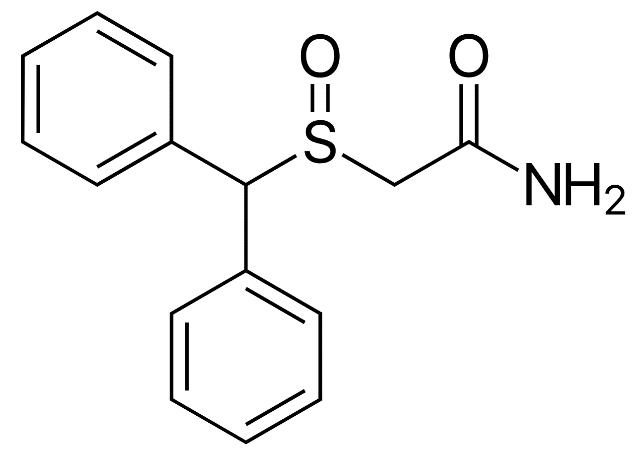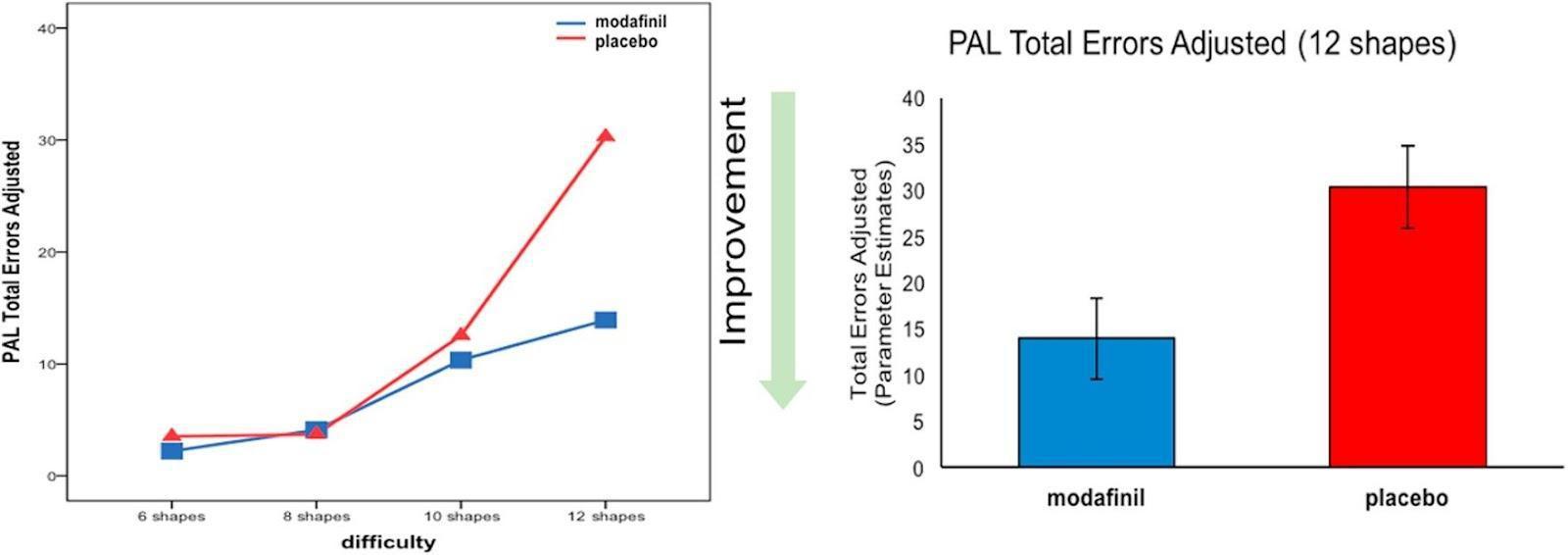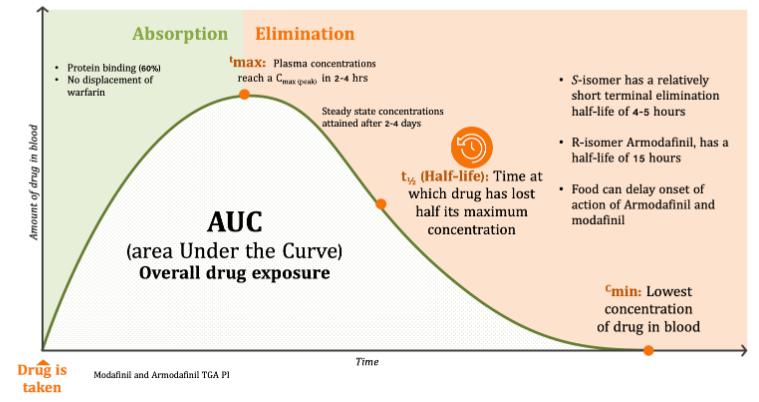
- Stock: Out Of Stock
- Package: 100mg / 20tab
Ask a Question About This Product
What is Modus 100mg (Modafinil)?
In the chemical world, Modafinil is known as Diphenylmethyl-sulfinylacetamide. It is a eugeroic medication approved by the FDA. The medication is used for the treatment of excessive daytime sleepiness. This condition is associated with obstructive sleep apnea (OSA), narcolepsy (a sudden attack of excessive daytime sleepiness), and shift work sleep disorder (SWSD). Although the chemical industry has other medications for this condition, such as amphetamines and methylphenidate, Modafinil is preferable by physicians since it does not cause dependency. If compared to traditional stimulants, Modafinil does not cause euphoric effects, which contributes to its lower potential for abuse and dependency.

The generic drug was developed by French neuroscientists Michel Jouvet and Lafon Laboratories in the late 1970s. However, it was released as a treatment for narcolepsy in France in the 1980s. At that time, it was named Modiodal.
Once the drug penetrates the body, it is rapidly absorbed. The maximum concentration in plasma is achieved within 2–4 hours after oral administration. Its half-life ranges between 10–12 hours, which is why it’s enough to take the drug once per day. The medication is metabolized by the liver and excreted via the kidneys. The drug contains metabolites such as Modafinil acid and Modafinil sulfone, which are pharmacologically inactive. These features make the medication suitable for people who need to stay awake sustainably and enjoy a cognitive function without the pronounced risk of dependence observed in other stimulants.
Primary Effects and Benefits
The main benefits of Modafinil include its properties that promote wakefulness and enhance cognitive abilities. The drug is effective in both clinical and non-clinical settings. It’s applicable to patients who suffer from sleep disorders or seek cognitive enhancement.
- Enhanced wakefulness. It’s the primary indication of the drug. Numerous clinical studies approved the efficacy of Modafinil in treating excessive daytime sleepiness. The medication is effective for people who have problems with sleep due to shift work or suffer from OSA or narcolepsy. According to the Maintenance of Wakefulness Test (MWT), the generic drug improves mean sleep latency, as well as reduces the frequency and severity of sleep attacks.
- Cognitive enhancement. The pharmaceutical product shows high efficacy in enhancing various aspects of cognitive function. In particular, it improves memory, attention, and executive functioning. In 2003, Turner et al. conducted a study, during which significant improvement of performance was observed. Patients carried out tasks that required working memory, sustained attention, and spatial planning. However, note that healthy individuals can also take the medication to improve their performance and cognitive capabilities. Thus, students and professionals also widely use the drug.
- Mood stabilization. Some studies found that the medication can cause mood-stabilizing effects in individuals who suffer from depression. In 2007, Fava et al. conducted research, during which the drug demonstrated significant improvements in depressive symptoms in patients with major depressive disorder (MDD). The component turned out to be effective while other selective serotonin reuptake inhibitors (SSRIs) didn’t work. However, the medication is used as an adjunctive treatment and is added to an overall therapy.
- Physical performance. According to the latest results, the drug can improve physical performance and endurance. This effect makes Modafinil suitable for bodybuilders and athletes. Jacobs et al. investigated its effects on physical performance after sleep. He found reduced perceived exertion during exercises, which allowed him to conclude that the drug contributes to energy release.
Mechanism of Action
The medication causes a versatile action, affecting diverse neural pathways and neurotransmitter systems. To understand its mechanisms of action, we should delve into its effect on various brain regions and explore neurotransmitter dynamics.
- Dopaminergic pathways. Modafinil affects the dopaminergic system significantly. The drug impedes the dopamine transporter (DAT), which allows for preventing the reuptake of dopamine into presynaptic neurons. This action results in an increase of an extracellular level of dopamine in brain areas responsible for cognition, attention, and motivation. Volkow studied the effect of Modafinil on the brain using positron emission tomography (PET) imaging. He found that Modafinil does not cause any euphoric effects like other traditional stimulants (like amphetamines or cocaine) do. This peculiarity of the drug contributes to its wide use for promoting wakefulness and enhancing cognitive properties.

- Histaminergic system. Modafinil affects the central histaminergic system activating its mechanisms. The system is responsible for maintaining human wakefulness. It acts through histamine neurons that are primarily located in the tuberomammillary nucleus (TMN) of the hypothalamus. Neurons are scattered in different areas of the brain, which influences various aspects of arousal and vigilance. The consumption of Modafinil enhances histamine release in the TMN. The drug stimulates an elevated amount of histamine in the body, which contributes to staying awake and resisting daytime sleepiness. Furthermore, when researching the medication, chemists found that the cognitive benefits observed during Modafinil use are similar to the sleep-wake cycle modulated by the histaminergic system.
- Orexinergic neurons. Modafinil interacts with orexin (hypocretin) neurons, which comes as one of the main features of its action. Orexin neurons are located in the lateral part of the hypothalamus. They perform a crucial role in keeping bodies awake and regulating the sleep-wake cycle. By penetrating the body, Modafinil causes an activating effect on these neurons, which results in an increased pace of orexin peptide release. Furthermore, peptides stimulate different areas of the brain, which are responsible for keeping the body awake during the day.
Adrenergic and Serotonergic Systems
The medication affects these systems as well, contributing to the overall amount of energy for the day and enhancing mood.
Adrenergic system. Under the impact of Modafinil, a higher amount of noradrenaline is released into the brain. Norepinephrine is a critical neurotransmitter involved in such processes as arousal, attention, and response to stress. By affecting the activity of these neurotransmitters, Modafinil helps achieve higher indicators of concentration and cognitive performance.
Serotonergic system. Modafinil also impacts the level of serotonin in the body. Serotonin (5-HT) is a significant neurotransmitter that regulates sleep, mood, and anxiety. The drug’s components increase the level of serotonin in different brain zones that are responsible for mood regulation.
Glutamatergic and GABAergic Systems
The latest studies highlight the beneficial effect of the medication on glutamate and GABA. These neurotransmitters are responsible for such reactions as excitement and inhibition.
Glutamatergic system. Modafinil enhances glutamate release in regions involved in arousal and memory. An increased activity of this neurotransmitter contributes to enhanced cortical arousal and improved cognitive functions.
GABAergic system. As for GABA, Modafinil reduces its production in the brain. GABA (gamma-aminobutyric acid) is the main neurotransmitter responsible for inhibition. The reduction of its release leads to increased arousal and excitability of neurons. By reducing the activity of this neurotransmitter, the medication prolongs wakefulness and relieves sleep disorders.
Hypothalamic-pituitary-adrenal (HPA) axis. This axis regulates the ability of the body to respond to stress. Modafinil has a modulating effect, which allows consumers to improve stress resistance and enhance cognitive performance under stress conditions. This feature is especially relevant to patients who need to maintain high performance during stress factors.
Cerebral blood flow and metabolism. Modafinil also affects the blood flow to the brain. According to studies, the medication increases regional cerebral blood flow (rCBF) in brain areas that are responsible for cognitive processing.
Uses
The primary use of Modafinil relates to sleep disorders. However, the unique pharmacological profile of the medication extended its scope of application to other areas as well. Here, let’s discuss the most popular cases of drug application.
- Narcolepsy. It’s a chronic sleep disorder characterized by excessive daytime sleepiness. Other severe side effects of this disorder include sleep paralysis, cataplexy, and hypnagogic hallucinations. In this case, Modafinil comes as one of the most effective treatments for patients with this diagnosis. The regular intake of the drug improves the quality of life and daily performance. In 2007, Hirshkowitz and Black conducted research that lasted for 12 weeks. An open-label study demonstrated the beneficial effect of Modafinil on patients and significant improvements in sleep latency and overall alertness.
- Obstructive sleep apnea (OSA). Patients with this condition use the medication as an adjunctive treatment in addition to regular therapy to reduce residual sleepiness. Numerous studies proved the effectiveness of the drug in improving cognitive and functional performance.
- Shift work sleep disorder. People who are engaged in work during non-traditional hours usually experience misalignment of their circadian rhythms. This drawback leads to severe problems with sleep since they feel sleepy during awakening hours while suffering from insomnia during intended sleep times. Modafinil showed a positive effect on the daily performance of shift workers, reducing the negative impact of irregular work schedules on their health and productivity.
Off-Label Uses
In addition to targeted disorders, the drug can be used off-label for several purposes. These include the following cases:
- Cognitive enhancement. Being a neuroenhancer, Modafinil can improve memory, focus, and productivity.
 The graphs show the effects of placebo and modafinil on task performance at different difficulty levels. Patients who consumed a placebo demonstrated stable performance during tasks of a low difficulty level, while slight declines for medium and high difficulty tasks were observed. It is especially relevant if we touch upon tasks with higher baseline performance. Modafinil shows moderate improvements for tasks of a low difficulty level while it leads to significant declines in medium and high difficulty tasks. This suggests that the drug benefits simpler tasks but its effectiveness decreases with increased task complexity.
The graphs show the effects of placebo and modafinil on task performance at different difficulty levels. Patients who consumed a placebo demonstrated stable performance during tasks of a low difficulty level, while slight declines for medium and high difficulty tasks were observed. It is especially relevant if we touch upon tasks with higher baseline performance. Modafinil shows moderate improvements for tasks of a low difficulty level while it leads to significant declines in medium and high difficulty tasks. This suggests that the drug benefits simpler tasks but its effectiveness decreases with increased task complexity. - Attention-deficit / hyperactivity disorder (ADHD). In such cases, Modafinil comes as an alternative to traditional medical stimulants like amphetamines and methylphenidate. Recent studies suggest that the drug reduces hyperactivity and improves attention in ADHD patients.

On the graph, you can see how placebo and Modafinil affect episodic memory performance at varying difficulty levels. To illustrate the difference, the Paired Associates Learning (PAL) test was used.
Left graph. The total errors adjusted are plotted for tasks with 6, 8, 10, and 12 shapes. Modafinil consumers make fewer errors than patients who take a placebo. This tendency becomes more noticeable as task difficulty increases. ANOVA measures are used to control baseline performance. They demonstrate a significant main effect of modafinil (F = 6.199, p = .01, ηp² = .10).
Right graph. If you look at the most difficult level (marked 12 shapes), modafinil leads to significantly fewer errors compared to placebo (F = 4.211, p = .02, ηp² = .13).
Overall, the result of this research suggests that Modafinil significantly enhances episodic memory performance, particularly on more challenging tasks.
- Depression. When combined with traditional antidepressants, Modafinil is used as part of complex therapy for major depressive disorder. The medication demonstrated high efficacy in relieving depressive symptoms.
- Cocaine addiction. Nowadays, investigations of the possible beneficial effects of Modafinil in treating cocaine addiction are carried out. Possible benefits are explained by several reasons related to the biochemical mechanism involving both drugs. Recent observations notice that Modafinil is partially opposite to the symptoms of cocaine withdrawal. According to such studies, cocaine-addicted patients who take Modafinil can spend more consecutive days without cocaine use. However, no statistically significant effect on the rate of change in the percentage of cocaine-free days was found.
- Weight loss. Investigations found that the medication causes appetite suppression and weight loss. These signs were observed even in healthy individuals without extra kilos. The Medline database keeps records of all studies conducted in this domain. They prove that patients who take Modafinil experience weight loss if compared to a placebo group. Thus, a study carried out in 208 showed that individuals consume 18% fewer calories per day when taking Modafinil 200 mg, while the intake of 400 mg tablets reduced the consumption of calories by 38%.
Dosage, Administration, and Precautions
The bioavailability of Modafinil is over 80%. The maximum concentration of the component in the body is registered in 2–4 hours after administration. If pills are taken during meals, food can slow down ingredient absorption. However, it does not affect the overall area under the concentration-time curve. The half-life usually ranges from 10 to 15 hours; it can vary based on the genotype of cytochrome P450 enzymes, as well as liver and kidney function.

Dosage
Hypersomnia associated with narcolepsy and OSA: it’s recommended to take a single dosage of 200 mg in the morning. However, some research suggests that twice-daily administration (in the morning and at noon) of 200 mg is more effective. Note that the intake of a single dosage of 400 mg does not cause a significant boost in efficacy compared to Modafinil 200 mg.
Sleepiness associated with shift work: it’s recommended to take 200 mg of Modafinil once a day 1 hour before the shift. A single 300 mg dosage also demonstrates high effectiveness. However, individuals who have high sensitivity to the medication’s components can experience a significant effect even with a dosage of 100 mg.
Anyway, the daily dosage should not exceed 400 mg, regardless of the disorder, its severity, and other factors. Taking the medication in the second half of the day is not recommended as Modafinil is slowly excreted from the body. Since the half-life is 12–15, taking the drug in the second half of the day may cause problems with nighttime sleep.
It’s recommended to start taking the medication with a single dosage of 50–100 mg, gradually increasing it to 200 mg or more until the desired effect becomes noticeable.
Administration
It’s possible to take the drug both with and without food. However, note that if you take the medication with food, the onset of its effect is slightly delayed due to slower absorption. It’s essential to maintain consistent timing of drug administration to keep the optimal level of plasma and optimize its therapeutic benefits.
Frequency of Intake
The cognitive enhancer is designed for daily administration. It’s a prescription medication typically designed for conditions like narcolepsy, sleep apnea, ADHD, and multiple sclerosis.
Productivity Enhancement
If you want to boost productivity, you need to consume it regularly 2–4 times a week.
If you want to consume the drug as a "rescue aid" for urgent tasks, occasional intakes for 1–2 times a month are enough.
Adjusting Frequency
It’s recommended to start with lower frequency (e. g., once a week) and gradually increase the dosage based on your body's response.
Remember to monitor cognitive performance and side effects.
Potential Consequences
If you take Modafinil pills daily, the medication’s components are present in the body continuously. Make sure to avoid alcohol and cigarettes.
Note that withdrawal symptoms can be observed when you decide to discontinue daily use.
If you notice any side effects, you need to adjust the frequency of intake and the dosage.
Best Practices
Use modafinil only when necessary for enhancing cognitive functions.
Regularly assess your needs and adjust intake frequency to avoid dependence.
Precautions
Patients who suffer from such cardiovascular issues as hypertension, angina, or arrhythmias, should use the medication with caution due to potential cardiovascular side effects. Since Modafinil is metabolized by the liver, consumers should monitor liver function regularly.
Drug Interactions
- When combined with Yohimbine, Modafinil combination can cause a dangerous increase in heart rate and blood pressure.
- When Modafinil is mixed with hormonal contraceptives, reduced effectiveness of the latter is observed.
- If you drink coffee regularly, blending it with Modafinil can be dangerous for individuals who suffer from cardiovascular disorders. The thing is that both substances have a strong impact on the nervous and cardiovascular systems. Thus, if you have any minor cardiovascular or nervous system issues, they will aggravate them.
- Simultaneous use of Modafinil and alcohol can be dangerous. This argument is explained by the opposite effect of both substances. In particular, alcohol increases the activity of gamma-aminobutyric acid (GABA) and reduces glutamate activity. In contrast, Modafinil acts as a source of GABA and accelerates glutamate synthesis. Additionally, alcohol inhibits many processes in the brain, while modafinil stimulates brain activity. The result of this "tug of war" in the brain can be unpredictable.
- There is no data about the interaction of Modafinil and MAO inhibitors. Thus, this effect is not investigated sufficiently. Take caution if you consume both substances.
- Psychiatric conditions: patients with a history of psychiatric disorders, including depression, anxiety, and psychosis, should stay under precise monitoring when using Modafinil, as it can aggravate these conditions.
Side Effects
Modafinil is generally well-tolerated, but like all medications, it can cause side effects. These side effects can range from mild to severe.
Common Side Effects
- Headache. Most patients report headaches, ranging from mild to severe forms.
- Nausea. Mild forms are common. However, it’s possible to reduce this side effect if consuming Modafinil with food.
- Nervousness. Increased anxiety or jitteriness are observed. Especially, when patients take higher doses.
- Dizziness. Many consumers feel lightheaded or unsteady.
- Insomnia. If patients consume Modafinil 100 mg late in the day, they can face problems with sleeping at night.
- Dry mouth. Consumers feel unpleasant dryness in the mouth.
- Diarrhea. Gastrointestinal discomfort and loose stools are frequently reported.
- Decreased appetite. Patients usually have a reduced desire to eat, which leads to potential weight loss.
- Back pain. Quite frequently, consumers report mild to moderate discomfort in the back.
Rare Side Effects
- Serious skin reactions, including Stevens-Johnson syndrome (SJS) and toxic epidermal necrolysis (TEN). If such side effects are noticed, they require immediate reaction since they can threaten your life.
- Psychiatric symptoms, such as hallucinations, mania, depression, and suicidal thoughts. Such conditions are common for patients with a history of psychiatric disorders.
- Chest pain. It can be a possible sign of cardiovascular issues, which is why it requires immediate medical evaluation.
- Palpitations (rapid or irregular heartbeats).
- Shortness of breath. It implies difficulty while breathing and can indicate a serious condition.
- Problems with the liver, including such symptoms as dark urine, jaundice (yellowing of the skin or eyes), and persistent nausea/vomiting.
- Severe allergic reactions, including such symptoms as rash, itching/swelling (especially of the face/tongue/throat), severe dizziness, and trouble breathing.
Storage
- Temperature. Consumers should store Modafinil at room temperature, between 20 to 25 °C (68 to 77 °F). Temporary excursions are permissible between 15 and 30 °C (59 and 86 °F).
- Humidity. Keep the medication in a dry place, away from moisture. Avoid storing it in the bathroom where humidity levels can fluctuate.
- Light. Store Modafinil in its original packaging to protect it from light since the light can degrade the medication over time.
- Safety. Keep Modafinil out of reach of children and pets. Ensure that the container is tightly closed to prevent accidental ingestion.
Why to Choose Us?
Driada Medical Store is a trusted online retailer of pharmaceuticals and food supplements. We offer to buy Modafinil 100 mg online without a prescription. A wide catalog of certified products is provided to prolong well-being and support health.
We are not just an online store. We take our effort to create a community of like-minded people, where all members can find answers to their questions and get professional support. Thus, we are a reputable Modafinil shop.
Our Advantages
Here are the main reasons why our store is the best place to order Modafinil.
- A wide catalog of products. If you want to buy a smart drug, we offer a diverse assortment of pharmaceuticals and dietary supplements.
- 100% guarantee of product quality. Our products are laboratory-tested to ensure their quality and safety. Popular products are tested multiple times. Customers can verify their test results, using a unique code for laboratory tests.
- Reasonable pricing. We set an affordable Modafinil 100 mg price. The cost justifies product quality.
- Free consultation for clients. Customers can join @driadacycleadvice_bot. It helps select a suitable energy pill and provides extra services, such as blood test interpretation, treatment cycle development, etc.
- Worldwide delivery. Free delivery is included in the Modafinil price. We supply our products to any corner of the globe and develop effective routes to deliver purchases.
- Delivery guarantee. This service is included in the Modafinil best price. If your parcel is lost on the way due to a carrier or some other reasons, we resent it. Thus, we guarantee that our clients get their purchases.
- Transparency. We offer video reviews of our facility to show what conditions medications are produced. Modern machinery and advanced technologies are implemented. And every client can enjoy an online journey across our infrastructure.
Thus, Driada Medical Store is the leading Modafinil online shop, where you can buy a performance enhancer. Contact our managers to make an online purchase and buy a cheap Modafinil online. They will be glad to assist you and make an order.
FAQ
Why do I feel so good on Modafinil?
Modafinil improves mood and reduces fatigue, as well as has a similar effect to amphetamines or cocaine, but it does not cause addiction.
Is Modafinil an ADHD drug?
It’s approved that the drug reduces hyperactivity and improves attention in ADHD patients. Due to this effect, it can be used as part of the complex therapy of ADHD conditions.
Is Modafinil similar to Vyvanse?
Yes, both components are similar. However, they are used for different conditions. While Modafinil is primarily used for the treatment of sleep disorders, Vyvanse is designed for ADHD.
How long will Modafinil keep you awake?
The effect lasts for 12–15 hours until the component is excreted from the body.



-960x450w.jpg)